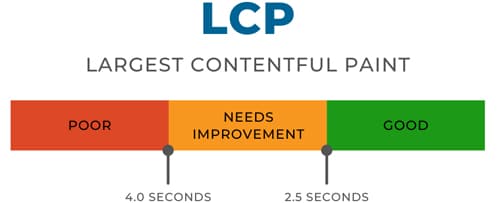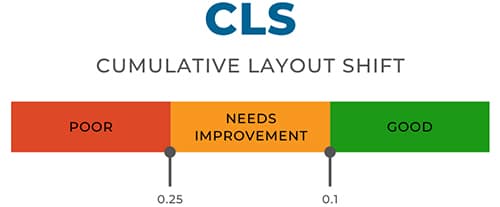Core Web Vitals & Ranking Signals: How They Affect Your Website
Jan 30, 2021 | 5 MINUTES TO READ

Summary: Google is updating the ranking metrics to include a selection of Core Web Vitals. Ensure your business stays on top by preparing for the change now.
If you manage a website, you know how important it is to pay attention to any new web metrics that Google introduces. Coming later this year, Google is introducing Core Web Vitals, the latest addition to their user experience metrics.

The factors that make up the Core Web Vitals are already extremely important but will assume more relevance for SEO in the coming months. Understanding what they are, why they matter, and how you can improve your website’s scores will help you achieve better SEO results and an overall positive experience for your customers.
What Are Core Web Vitals?
Core Web Vitals focus on three important aspects of a user’s experience on your website. These areas are scored based on how well your site meets the required criteria. The three key metrics that make up a website’s Core Web Vitals are:
- Largest Contentful Paint
- First Input Delay
- Cumulative Layout Shift
Largest Contentful Paint

The content on this section of your webpage should be informative and to-the-point. It should also load fully in 2.5 seconds or less on both desktop and mobile devices.
First Input Delay

This metric does not always apply to blog posts and informational pages, but it is critical for pages like sign-up forms, landing pages, and e-commerce storefronts. Webpages that require user interactivity must take steps to make those interactions swift, smooth, and responsive.
Cumulative Layout Shift

Many users consider this extremely disruptive, so it is factored against you in the scoring process. The more movement users see the higher your CLS score will be. You should aim to get your score as close to zero as possible.
Why Core Web Vitals Matter
Core Web Vitals were not randomly chosen by Google’s engineers. This specific assortment of metrics incorporates key factors that users consider when deciding whether to leave a webpage they have just landed on. If you lose too many visitors like this, you will be giving up a significant amount of your hard-earned web traffic.
Google has found that users are 24% less likely to leave a webpage early if that page conforms to Core Web Vitals standards. This means that paying attention to your scores will lead to:
- Happier users.
- Lower bounce rates.
- Potential for improved conversion rates.
How to Track and Improve Core Web Vitals
Tracking Core Web Vitals is extremely easy and intuitive. The Google Search Console’s Core Web Vitals report function will provide you with all the information you need to ensure your site meets the relevant benchmarks. The report classifies each page of your website as one of the following:
- Poor.
- Needs improvement.
- Good.
It also identifies the specific problems that led to that classification, making them easier to address. You can break this data down into mobile or desktop reports to optimize your site for both browsing methods.
Once you know where your webpage’s problems lie, your web developer or SEO agency can make targeted improvements. Here are some overall tips that will help raise your scores.
- Reserve the top of each page for the most important information.
The user should be able to solve the problem that brought them to the page using what is located here. - Simplify your webpages.
Small file transfer sizes, minimal third-party code, and low JavaScript execution times help make pages load faster and stay responsive. - Optimize your website element for speed.
Pay attention to sizing when inserting images and videos and limit your use of transformation animations. This should improve the stability of your webpage as it loads.
Core Web Vitals Will Become Major Google Ranking Signals by June 2021
Core Web Vitals already provide invaluable data regarding user experience on your site, but they are about to become even more important. Google has pre-emptively announced that they intend to make Core Web Vitals a part of their search engine ranking criteria starting June 2021.
This does not mean that other SEO elements will become irrelevant or outdated. Google plans to continue to factor existing UX metrics into their rankings alongside Core Web Vitals, so it is still important to pay attention to things like mobile optimization and page load speed. Investing in SEO services can help you rank for these factors as well.
However, it is important to note that any webpage that is not designed with Core Web Vitals in mind will not reach its full ranking potential after June 2021.
Prepare for the June 2021 Google Core Web Vitals Update with Our SEO Services
Core Web Vitals will soon join the long list of factors you must account for when constructing your website’s SEO strategy. Understanding and optimizing your website for them now will let you capitalize on these changes instead of suffering because of them.
WSI Comandix also offers SEO services that will help your business adapt to these new standards. We will help you fine-tune your website’s content and design in pursuit of that highly coveted top SERP spot.
Let us show you how we can help get you ready for the coming shifts in the SEO landscape. Contact us for a free web audit and see how your site measures up.
If you need to modify your site to prepare for the latest metric changes, ask us about our standalone Core Web Vitals update service!
Also Read:
How Google’s May 2020 Update May Affect Your Rankings
SEO Trends to Watch For in 2021
Don't stop the learning now!
Here are some other blog posts you may be interested in.
VIEW ALL BLOG POSTS-
Core Web Vitals & Ranking Signals: How They Affect Your Website
If you manage a website, you know how important it is to pay attention to any new web metrics that Google introduces …
READ MORE -
How to Know If Core Web Vitals Are Affecting Your Search Rankings
If you follow marketing news in any capacity, you have probably heard about the new core web vitals update (also called the page experience update). This search …
READ MORE -
Google MUM: How to Prepare for the Latest Google Update
Anyone who works in marketing and SEO knows that Google’s algorithms constantly change. Each update usually brings small changes that improve the user …
READ MORE








